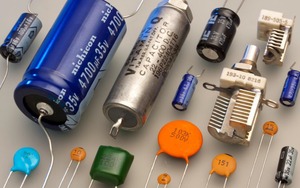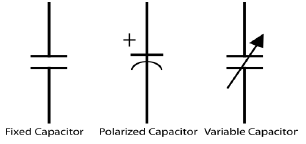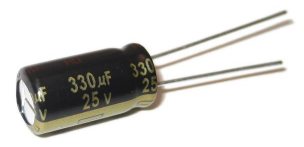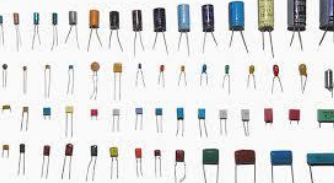What is a Capacitor?
Author: Tyson Popynick Date Posted:3 April 2016

What is a capacitor?
A capacitor is an analog component that is able to temporarily store an electric charge. It differs from a battery both in composition, as well as method of operation.
What is the schematic symbol for a capacitor?
The image below is fairly self-explanatory. Each symbol represents a different type of capacitor. Polarized also show polarity. Capacitors such as electrolytics need to be placed in the correct orientation. The leads are marked on components where this is important, and once again – any doubt can be tampered with a quick google search on “polarized capacitors”.

How do I tell its value?
Capacitors are marked with their values in a variety of ways. Electrolytic Capacitors often have their voltage and capacitance rating marked on the casing. If you are ever in doubt, most Digital Multimeters are capable of measuring capacitance. Alternatively a quick google search for “identifying capacitors” will give you plenty of examples of the differing types.

What are some common uses?
Capacitors are commonly used to decouple signals, or remove noise. They make great filters in certain applications. They can be used to buffer power to a device the intermittently needs a little extra.
They are used in RC circuits, in conjunction with a resistor to oscillate. There are many uses that you will come across in your adventures! It can be difficult to imagine yourself knowing when to use these components sometimes, however with practice comes skill, and the more you look at electronics and tinker, the more you will learn.
What are capacitors made of?
Capacitors consist of a conductive material interleaved with a non-conductive material. You can make one yourself to test by laying down a small strip of aluminum foil, placing a sheet of paper over the top of this, then complete the stack by adding another layer of aluminum. The 2 aluminum layers should not touch each other at all. Attach one “lead” to each sheet, then roll the stack. This is your capacitor, Wrap it in insulation and measure it on your multimeter! What capacitance did you get?
How do capacitors work?
As electrons flow into the foil they create a magnetic field, which collapses and induces a related release of electrons. The amount of energy the field can store and release is capacitance.
Example Use:
We may have a sensor near an electric motor. The motor may be causing the sensor readings to be off due to noise or feedback. A decoupling capacitor would essentially filter this noise out, while allowing the sensor values to remain.

Useful Resources and Links:
Wikipedia (Contains a wealth of information, as well as further reading links)
NOTE:
Capacitors are very handy devices for a range of uses. They are commonly used to set values in integrated components along with resistors. It is quite a good idea to purchase a bulk pack of capacitors as well as resistors so you have a range of values on hand. They are not an expensive component.

